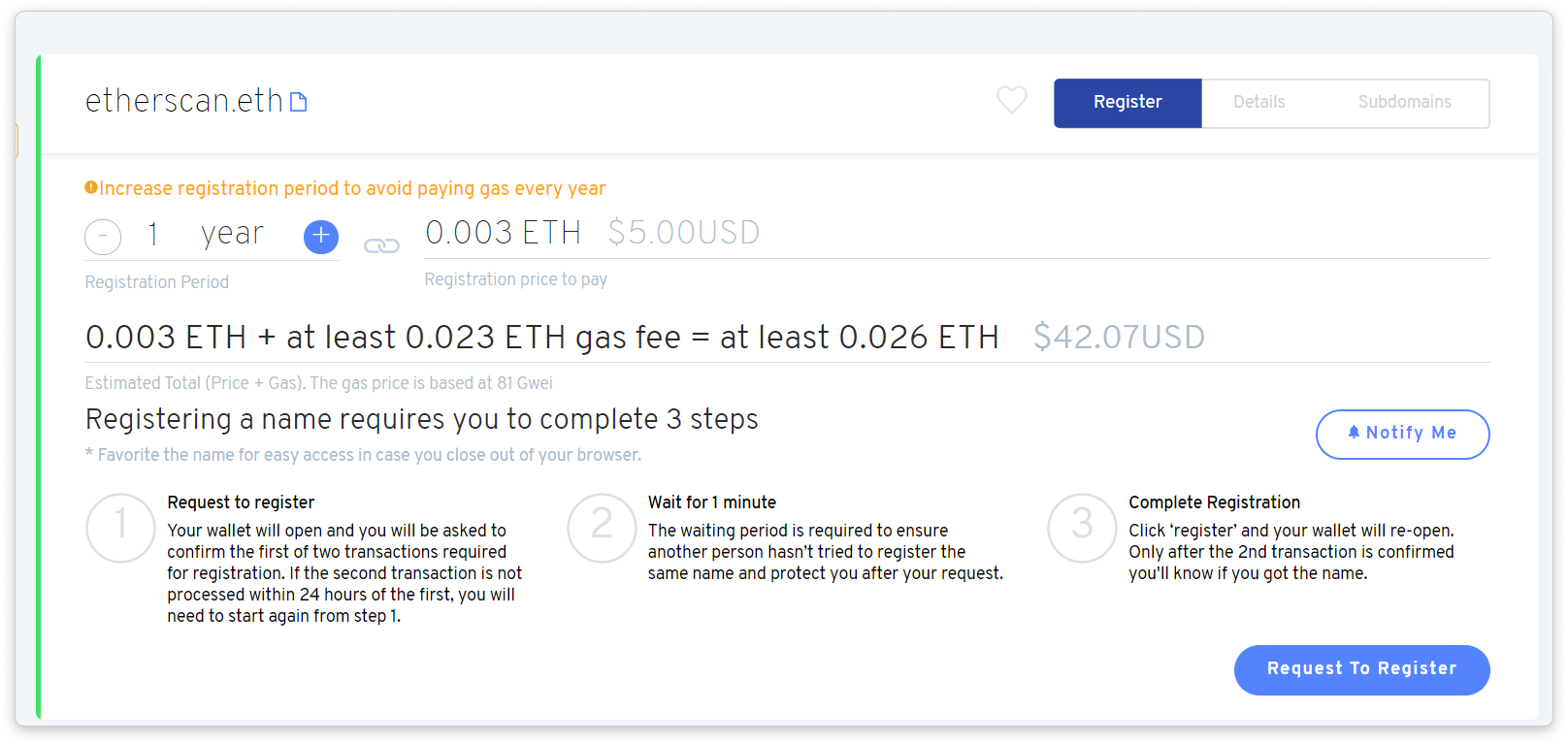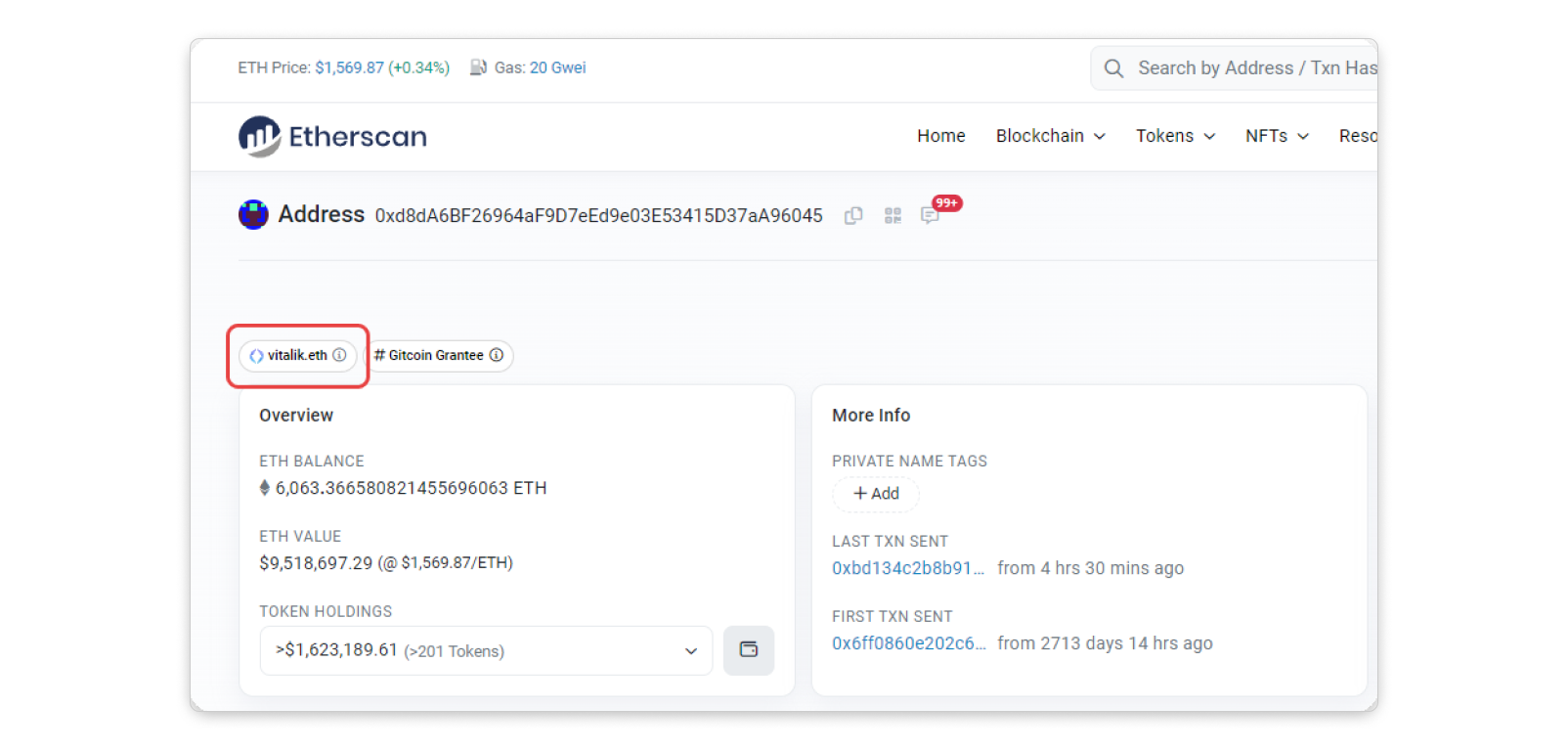ENS Name Tags on Etherscan
ENS, or the Ethereum Name Service, is a name extension built on top of the Ethereum blockchain. It enables users to register human-readable names (such as "mynft.eth") that can be used to interact with Ethereum smart contracts, decentralized applications (dApps), and other blockchain-based services.
ENS translates human-readable name extension into Ethereum addresses or other metadata associated with those addresses, such as a public key for receiving cryptocurrency payments or a decentralized website hosted on the InterPlanetary File System (IPFS).

ENS allows users to send and receive cryptocurrency payments using easy-to-remember names instead of long and complicated Ethereum addresses. For example, instead of sending cryptocurrency to 0x56d3D65...F08Bf, a user can send it to "mynft.eth". This makes it much easier for people to remember and use their Ethereum addresses, especially as more services and applications are built on the Ethereum network.
On Etherscan, we've enabled ENS to be shown directly on the website's interface as Name Tags:

We also provide users with a directory to:
- Key in an address to search for the associated ENS name(s), or
- Key in an ENS name to search for the resolved address


Each ENS name contains a set of useful information that is tied to a specific address, these include:
- Resolved Address: The main address resolved from the ENS name.
- Expiration Date: The date the name expires, upon which there is a 90 day grace period for the owner to renew. After the 90 days, the name is released to the market.
- Registrant: The account that owns the ENS name and has the rights to edit its ownership and records.
- Controller: The account that owns the rights to edit the records of this ENS name.
- Token ID: The token ID of this ENS name NFT.
- Other Addresses: Other crypto addresses added to this ENS name.
- Content: Content hashes added to this ENS name.
- Text Records: Extra information added to this ENS name.
How to Add an ENS Name Tag
To have the Name Tag displayed on Etherscan, you'll need to set up both forward and reverse resolution and point each to the same address & name.
Steps:
[start]
- Look for and register an available ENS domain here: app.ens.domains

[--------]
- Set reverse record

[--------]
- Check that your reverse record is set correctly

[--------]
- Make sure that the forward resolved address (the first address under Records) is set to the same address used for reverse record

[--------]
Once you have completed the steps above, voila! You will see your ENS Name Tag displayed proudly on the Address page on Etherscan.

[end]
Important Considerations
- An ENS domain may not necessarily be owned by the person or entity popularly associated with the name. For example, elon.eth and tesla.eth may have been bought by a random member of the Ethereum community instead of Elon Musk or Tesla, Inc. Please take care not to fall for any tricks related to any mis-association of names.
- Some domain names can be bought that includes characters from more than one Unicode alphabet. This may also be used to trick unsuspecting users. For example, the name vítalik.eth (with one i having an accent mark) could be used in a phishing attempt.
- If you prefer not to have your ENS domain displayed on Etherscan, simply remove either the forward or reverse record from the same address.
Frequently Asked Questions:
Why isn't the ENS Name displayed on the contract address page?
Currently on Etherscan, the ENS name for a contract address will only be displayed if the setNameForAddr function is called during the ENS reverse resolution setup.
Learn how to setup ENS reverse resolution for a contract address here.
Why does it show [Invalid ENS Name] when I attempt to look up an ENS Name?
ENS name tags displayed on Etherscan follow the ENSIP15: Normalization Standard. If a name registered through ENS does not adhere to ENSIP15, it will be shown as [Invalid ENS Name]. Here are a few examples of names that do not adhere to ENSIP15:
- Names that contain Zero Width Joiners (E.g.: 🦹🏿%e2%80%8d♀.eth and %e2%80%8d%e2%80%8dbtc.eth)
- Names that contain leading or trailing spaces (E.g.: %205768.eth)
Why is the public name tag being displayed instead of an ENS name?
When an address has both a public name tag and an ENS name, the public name tag will be prioritized for display.
Read: How to remove public name tag?
Why is my CCIP Read ENS name not being displayed in my address page on Etherscan?
While Etherscan supports lookups of CCIP Read ENS names, we do not currently support the display of CCIP Read ENS name tags on the address page.
